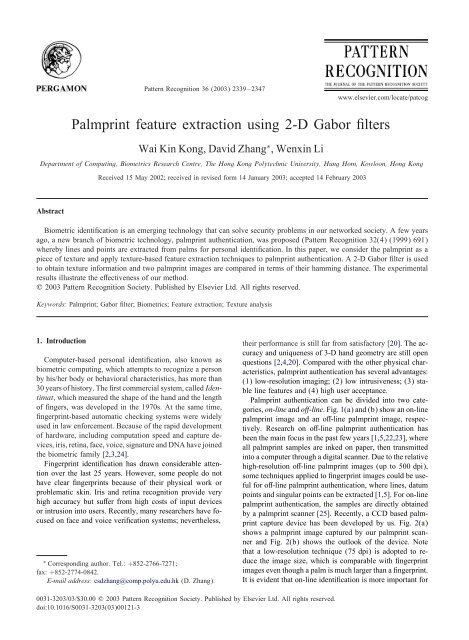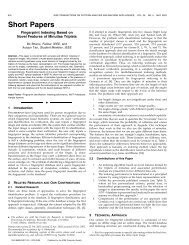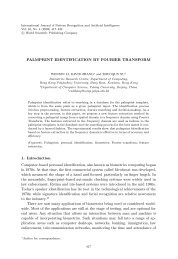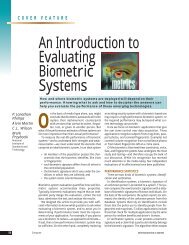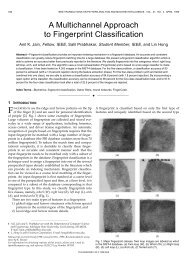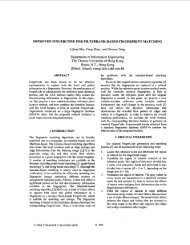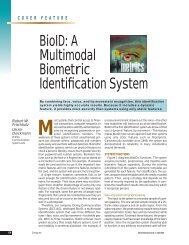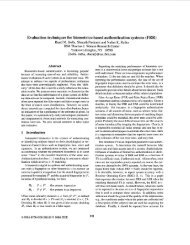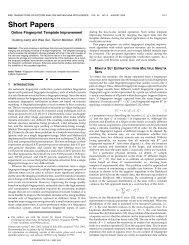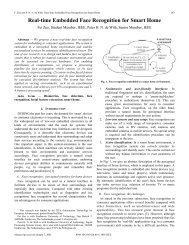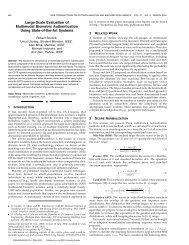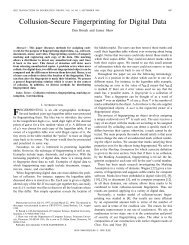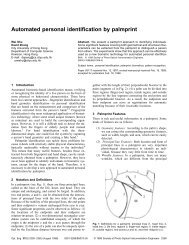Palmprint feature extraction using 2-D Gabor filters
Palmprint feature extraction using 2-D Gabor filters
Palmprint feature extraction using 2-D Gabor filters
Create successful ePaper yourself
Turn your PDF publications into a flip-book with our unique Google optimized e-Paper software.
Pattern Recognition 36 (2003) 2339 – 2347<br />
www.elsevier.com/locate/patcog<br />
<strong>Palmprint</strong> <strong>feature</strong> <strong>extraction</strong> <strong>using</strong> 2-D <strong>Gabor</strong> lters<br />
Wai Kin Kong, David Zhang ∗ , Wenxin Li<br />
Department of Computing, Biometrics Research Centre, The Hong Kong Polytechnic University, Hung Hom, Kowloon, Hong Kong<br />
Abstract<br />
Received 15 May 2002; received in revised form 14 January 2003; accepted 14 February 2003<br />
Biometric identi cation is an emerging technology that can solve security problems in our networked society. A few years<br />
ago, a new branch of biometric technology, palmprint authentication, was proposed (Pattern Recognition 32(4) (1999) 691)<br />
whereby lines and points are extracted from palms for personal identi cation. In this paper, we consider the palmprint as a<br />
piece of texture and apply texture-based <strong>feature</strong> <strong>extraction</strong> techniques to palmprint authentication. A 2-D <strong>Gabor</strong> lter is used<br />
to obtain texture information and two palmprint images are compared in terms of their hamming distance. The experimental<br />
results illustrate the e ectiveness of our method.<br />
? 2003 Pattern Recognition Society. Published by Elsevier Ltd. All rights reserved.<br />
Keywords: <strong>Palmprint</strong>; <strong>Gabor</strong> lter; Biometrics; Feature <strong>extraction</strong>; Texture analysis<br />
1. Introduction<br />
Computer-based personal identi cation, also known as<br />
biometric computing, which attempts to recognize a person<br />
by his/her body or behavioral characteristics, has more than<br />
30 years of history. The rst commercial system, called Identimat,<br />
which measured the shape of the hand and the length<br />
of ngers, was developed in the 1970s. At the same time,<br />
ngerprint-based automatic checking systems were widely<br />
used in law enforcement. Because of the rapid development<br />
of hardware, including computation speed and capture devices,<br />
iris, retina, face, voice, signature and DNA have joined<br />
the biometric family [2,3,24].<br />
Fingerprint identi cation has drawn considerable attention<br />
over the last 25 years. However, some people do not<br />
have clear ngerprints because of their physical work or<br />
problematic skin. Iris and retina recognition provide very<br />
high accuracy but su er from high costs of input devices<br />
or intrusion into users. Recently, many researchers have focused<br />
on face and voice veri cation systems; nevertheless,<br />
∗ Corresponding author. Tel.: +852-2766-7271;<br />
fax: +852-2774-0842.<br />
E-mail address: csdzhang@comp.polyu.edu.hk (D. Zhang).<br />
their performance is still far from satisfactory [20]. The accuracy<br />
and uniqueness of 3-D hand geometry are still open<br />
questions [2,4,20]. Compared with the other physical characteristics,<br />
palmprint authentication has several advantages:<br />
(1) low-resolution imaging; (2) low intrusiveness; (3) stable<br />
line <strong>feature</strong>s and (4) high user acceptance.<br />
<strong>Palmprint</strong> authentication can be divided into two categories,<br />
on-line and o -line. Fig. 1(a) and (b) show an on-line<br />
palmprint image and an o -line palmprint image, respectively.<br />
Research on o -line palmprint authentication has<br />
been the main focus in the past few years [1,5,22,23], where<br />
all palmprint samples are inked on paper, then transmitted<br />
into a computer through a digital scanner. Due to the relative<br />
high-resolution o -line palmprint images (up to 500 dpi),<br />
some techniques applied to ngerprint images could be useful<br />
for o -line palmprint authentication, where lines, datum<br />
points and singular points can be extracted [1,5]. For on-line<br />
palmprint authentication, the samples are directly obtained<br />
by a palmprint scanner [25]. Recently, a CCD based palmprint<br />
capture device has been developed by us. Fig. 2(a)<br />
shows a palmprint image captured by our palmprint scanner<br />
and Fig. 2(b) shows the outlook of the device. Note<br />
that a low-resolution technique (75 dpi) is adopted to reduce<br />
the image size, which is comparable with ngerprint<br />
images even though a palm is much larger than a ngerprint.<br />
It is evident that on-line identi cation is more important for<br />
0031-3203/03/$30.00 ? 2003 Pattern Recognition Society. Published by Elsevier Ltd. All rights reserved.<br />
doi:10.1016/S0031-3203(03)00121-3
2340 W.K. Kong et al. / Pattern Recognition 36 (2003) 2339 – 2347<br />
Fig. 1. Examples of (a) on-line, with line de nitions and (b) o -line palmprint images.<br />
many real-time applications, so that it draws our attention<br />
to investigate.<br />
Our on-line palmprint veri cation system contains ve<br />
modules, palmprint acquisition, preprocessing, <strong>feature</strong> <strong>extraction</strong>,<br />
matching and storage. Fig. 3 gives a block diagram<br />
to describe the relationship between the ve modules. The<br />
ve modules are described below:<br />
(1) <strong>Palmprint</strong> Acquisition: A palmprint image is captured<br />
by our palmprint scanner and then the AC signal is<br />
converted into a digital signal, which is transmitted to a<br />
computer for further processing.<br />
(2) Preprocessing: A coordinate system is set up on basis<br />
of the boundaries of ngers so as to extract a central<br />
part of a palmprint for <strong>feature</strong> <strong>extraction</strong>.<br />
(3) Textured Feature Extraction: We apply a 2-D <strong>Gabor</strong><br />
lter to extract textural information from the central part.<br />
(4) Matching: A distance measure is used to measure the<br />
similarity of two palmprints.<br />
(5) Database: It is used to store the templates obtained from<br />
the enrollment phase.<br />
Our palmprint authentication system can operate in two<br />
modes, enrollment and veri cation. In the enrollment mode,<br />
a user is to provide several palmprint samples to the system.<br />
The samples are captured by our palmprint scanner and<br />
passes through preprocessing and <strong>feature</strong> <strong>extraction</strong> to produce<br />
the templates stored in a given database. In the veri -<br />
cation mode, the user is asked to provide his/her user ID and<br />
his/her palmprint sample. Then the palmprint sample passes<br />
through preprocessing and <strong>feature</strong> <strong>extraction</strong>. The extracted<br />
<strong>feature</strong>s are compared with templates in the database belonging<br />
to the same user ID.<br />
In this paper, we attempt to apply a textural <strong>extraction</strong><br />
method to palmprint images for personal authentication. The<br />
remaining sections are organized as follows: preprocessing<br />
steps are mentioned in Section 2. <strong>Palmprint</strong> <strong>feature</strong> extrac-<br />
tion by texture analysis is explained in Section 3. Experimental<br />
results are given in Section 4. Finally, Section 5<br />
summaries the main results of this paper.<br />
2. <strong>Palmprint</strong> image preprocessing<br />
Before <strong>feature</strong> <strong>extraction</strong>, it is necessary to obtain a<br />
sub-image from the captured palmprint image and to eliminate<br />
the variations caused by rotation and translation. The<br />
ve main steps of palmprint image preprocessing are as<br />
follows (see Fig. 4):<br />
Step 1: Apply a low-pass lter to the original image. Then<br />
use a threshold, Tp, to convert this original image into a<br />
binary image as shown in Fig. 4(b). Mathematically, this<br />
transformation can be represented as<br />
B(x; y)=1 ifO(x; y) ∗ L(x; y) ¿ Tp; (1)<br />
B(x; y)=0 ifO(x; y) ∗ L(x; y) ¡Tp; (2)<br />
where B(x; y) and O(x; y) are the binary image and the<br />
original image, respectively; L(x; y) is a lowpass lter, such<br />
as Gaussian, and “∗” represents an operator of convolution.<br />
Step 2: Extract the boundaries of the holes, (Fixj;Fiyj)<br />
(i =1; 2), between ngers <strong>using</strong> a boundary-tracking algorithm.<br />
The start points, (Sxi;Syi), and end points, (Exi;Eyi)<br />
of the holes are then marked in the process (see Fig. 4(c)).<br />
Step 3: Compute the center of gravity, (Cxi;Cyi), of each<br />
hole with the following equations:<br />
Cxi =<br />
Cyi =<br />
M(i)<br />
j=1 Fixj<br />
; (3)<br />
M(i)<br />
M(i)<br />
j=1 Fiyj<br />
; (4)<br />
M(i)
Fig. 2. Capture device and captured palmprint images. (a) on-line<br />
palmprint image obtained by our palmprint scanner and (b) our<br />
palmprint capture device.<br />
where M(i) represents the number of boundary points in the<br />
hole, i. Then construct a line that passes through (Cxi;Cyi)<br />
and the midpoint of (Sxi;Syi) and (Exi;Eyi). The line equation<br />
is de ned as<br />
(Cyi − Myi)<br />
y = x<br />
(Cxi − Mxi)<br />
W.K. Kong et al. / Pattern Recognition 36 (2003) 2339 – 2347 2341<br />
MyiCxi − MxiCyi<br />
+ ; (5)<br />
Cxi − Mxi<br />
where (Mxi;Myi) is the midpoint of (Sxi;Syi) and (Exi;Eyi).<br />
Based on these lines, two key points, (k1;k2), can easily be<br />
detected (see Fig. 4(d)).<br />
Step 4: Line up k1 and k2 to get the Y -axis of the palmprint<br />
coordinate system and make a line through their mid point<br />
which is perpendicular to the Y -axis, to determine the origin<br />
of the coordinate system (see Fig. 4(e)). This coordinate<br />
system can align di erent palmprint images.<br />
Step 5: Extract a sub-image with the xed size on the<br />
basis of coordinate system, which is located at the certain<br />
part of the palmprint for <strong>feature</strong> <strong>extraction</strong> (see Fig. 4(f)).<br />
3. <strong>Palmprint</strong> <strong>feature</strong> <strong>extraction</strong> by texture analysis<br />
This section de nes our palmprint <strong>feature</strong> <strong>extraction</strong><br />
method, which includes ltering and matching. The motivation<br />
for <strong>using</strong> a <strong>Gabor</strong> lter in our palmprint research is<br />
rst discussed.<br />
3.1. <strong>Gabor</strong> function<br />
<strong>Gabor</strong> lter, <strong>Gabor</strong> lter bank, <strong>Gabor</strong> transform and <strong>Gabor</strong><br />
wavelet are widely applied to image processing, computer<br />
vision and pattern recognition. This function can provide<br />
accurate time-frequency location governed by the “Uncertainty<br />
Principle” [6,7]. A circular 2-D <strong>Gabor</strong> lter in the<br />
spatial domain has the following general form [8,9],<br />
G(x; y; ; u; )= 1<br />
2 2 exp<br />
<br />
− x2 + y 2<br />
2 2<br />
<br />
×exp{2 i(ux cos + uy sin )}; (6)<br />
where i= √ −1; u is the frequency of the sinusoidal wave;<br />
controls the orientation of the function and is the standard<br />
deviation of the Gaussian envelope. Such <strong>Gabor</strong> lters have<br />
been widely used in various applications [10–19]. In addition<br />
to accurate time-frequency location, they also provide<br />
robustness against varying brightness and contrast of images.<br />
Furthermore, the lters can model the receptive elds<br />
of a simple cell in the primary visual cortex. Based on these<br />
properties, in this paper, we try to apply a <strong>Gabor</strong> lter to<br />
palmprint authentication.<br />
3.2. Filtering and <strong>feature</strong> <strong>extraction</strong><br />
Generally, principal lines and wrinkles can be observed<br />
from our captured palmprint images (see Fig. 1(a)). Some<br />
algorithms such as the stack lter [21] can obtain the principal<br />
lines. However, these lines do not contribute adequately<br />
to high accuracy because of their similarity amongst different<br />
palms. Fig. 5 shows six palmprint images with similar<br />
principal lines. Thus, wrinkles play an important role in<br />
palmprint authentication but accurately extracting them is<br />
still a di cult task. This motivates us to apply texture analysis<br />
to palmprint authentication.
2342 W.K. Kong et al. / Pattern Recognition 36 (2003) 2339 – 2347<br />
Fig. 3. Block diagram of our palmprint veri cation system.<br />
Fig. 4. Main steps of preprocessing: (a) original image, (b) binary image, (c) boundary tracking, (d) key points (k1 and k3) detecting, (e)<br />
the coordinate system and (f) The central part of a palmprint.
Table 1<br />
The parameters of the 12 lters<br />
Levels No Sizes u<br />
1 1 9× 9 0 0.3666 1.4045<br />
2 9× 9 45 0.3666 1.4045<br />
3 9× 9 90 0.3666 1.4045<br />
4 9× 9 135 0.3666 1.4045<br />
2 5 17× 17 0 0.1833 2.8090<br />
6 17× 17 45 0.1833 2.8090<br />
7 17× 17 90 0.1833 2.8090<br />
8 17× 17 135 0.1833 2.8090<br />
3 9 35× 35 0 0.0916 5.6179<br />
10 35 × 35 45 0.0916 5.6179<br />
11 35 × 35 90 0.0916 5.6179<br />
12 35 × 35 135 0.0916 5.6179<br />
In fact, a <strong>Gabor</strong> function, G(x; y; ; u; ) with a special set<br />
of parameters ( ; ; u), is transformed into a discrete <strong>Gabor</strong><br />
lter, G[x; y; ; u; ]. The parameters are chosen from 12 sets<br />
of parameters listed in Table 1 based on the experimental results<br />
in the next section. In order to provide more robustness<br />
to brightness, the <strong>Gabor</strong> lter is turned to zero DC (direct<br />
current) with the application of the following formula:<br />
˜G[x; y; ; u; ]=G[x; y; ; u; ]<br />
n n i=−n j=−n G[i; j; ; u; ]<br />
−<br />
(2n +1) 2 ; (7)<br />
where (2n+1) 2 is the size of the lter. In fact, the imaginary<br />
part of the <strong>Gabor</strong> lter automatically has zero DC because<br />
W.K. Kong et al. / Pattern Recognition 36 (2003) 2339 – 2347 2343<br />
Fig. 5. Three six images with similar principal lines.<br />
of odd symmetry. This adjusted <strong>Gabor</strong> lter will convolute<br />
with a sub-image de ned in Section 2. The sample point<br />
in the ltered image is coded to two bits, (br;bi), by the<br />
following inequalities,<br />
br = 1 if Re[ ˜G[x; y; ; u; ] ∗ I] ¿ 0; (8)<br />
br = 0 if Re[ ˜G[x; y; ; u; ] ∗ I] ¡ 0; (9)<br />
bi = 1 if Im[ ˜G[x; y; ; u; ] ∗ I] ¿ 0; (10)<br />
bi = 0 if Im[ ˜G[x; y; ; u; ] ∗ I] ¡ 0; (11)<br />
where I is the sub-image of a palmprint. Using this coding<br />
method, only the phase information in palmprint images is<br />
stored in the <strong>feature</strong> vector. The size of the <strong>feature</strong> is 256<br />
bytes. Fig. 6 shows the <strong>feature</strong>s generated by the 12 lters<br />
listed in Table 1. This texture <strong>feature</strong> <strong>extraction</strong> method has<br />
been applied to iris recognition [13].<br />
3.3. <strong>Palmprint</strong> matching<br />
In order to describe clearly the matching process, each<br />
<strong>feature</strong> vector is considered as two 2-D <strong>feature</strong> matrices, real<br />
and imaginary. <strong>Palmprint</strong> matching is based on a normalized<br />
hamming distance. Let P and Q be two palmprint <strong>feature</strong> matrices.<br />
The normalized hamming distance can be de ned as<br />
D0<br />
=<br />
n n i=1 j=1<br />
(PR(i; j) ⊗ QR(i; j)+PI (i; j) ⊗ QI (i; j))<br />
2N 2<br />
;<br />
(12)
2344 W.K. Kong et al. / Pattern Recognition 36 (2003) 2339 – 2347<br />
Fig. 6. Original image from DBI and their <strong>feature</strong>s generated by<br />
12 lters listed in the Table: (a) original image, (b), (d) and (f)<br />
real parts of <strong>feature</strong>s from Levels 1–3 lters, respectively, (c), (e)<br />
and (g) imaginary parts of from Levels 1–3 lters, respectively.<br />
where PR(QR) and PI (QI ) are the real part and the imaginary<br />
part of P(Q), respectively; the Boolean operator, “⊗”,<br />
is equal to zero if and only if the two bits, PR(I)(i; j) and<br />
QR(I)(i; j) are equal and the size of the <strong>feature</strong> matrices<br />
is N × N . It is noted that D0 is between 1 and 0. The<br />
hamming distance for perfect matching is zero. In order to<br />
provide translation invariance matching, Eq. (12) can be<br />
improved as<br />
Dmin = min<br />
|s|¡S;|t|¡T<br />
min(N;N+s) min(N;N+t) i=max(1;1+s) j=max(1;1+t)<br />
where S = 2 and T = 2 control the range of horizontal and<br />
vertical translation of a <strong>feature</strong> in the matching process,<br />
respectively and<br />
H(s) = min(N; N + s) − max(1; 1+s): (14)<br />
The hamming distance, Dmin, can support translation matching;<br />
nevertheless, because of unstable preprocessing, it is<br />
not a rotational invariant matching. Therefore, in enrollment<br />
mode, the coordinate system is rotated by a few degrees<br />
and then the sub-images are extracted for <strong>feature</strong> <strong>extraction</strong>.<br />
Finally, combining the e ect of preprocessing and rotated<br />
<strong>feature</strong>s, Eq. (13) can provide both approximately rotational<br />
and translation invariance matching.<br />
4. Experimental results<br />
4.1. <strong>Palmprint</strong> database<br />
In the following experiments, a palmprint database contains<br />
4647 palmprint images collected from 120 individuals<br />
by <strong>using</strong> our palmprint scanner. Forty-three of them are female,<br />
111 of them are less than 30 years old and 2 of them<br />
are more than 50 years old. Each of them is asked to provide<br />
about 10 images for their left palm and 10 images for their<br />
right palm in each of two occasions. In total, each subject<br />
provides about 40 images. The average time di erence of<br />
the rst and second occasions is 81 days. The maximum and<br />
minimum are 4 and 162 days, respectively. Originally, the<br />
collected images have two sizes, 384 × 284 and 768 × 568.<br />
The large images are resized to 384 × 284; consequently,<br />
the size of all the test images in the following experiments<br />
is 384 × 284 with 75 dpi resolution. The central parts of<br />
each image extracted with size 128 × 128 are named DBI.<br />
The preprocessed images in DBI resized to 64 × 64 are<br />
named DBII. The DBII is used to test the possibility of <strong>using</strong><br />
lower-resolution palmprint images for personal identi -<br />
cation. Fig. 7 shows nine typical images from our databases.<br />
4.2. Veri cation tests<br />
To obtain better parameters for our system, 12 di erent<br />
sets of parameters listed in Table 1 are used to test the<br />
method. The rst four lters are named as Level 1 lters<br />
since they are di erent in the parameter, . Similarly, the<br />
other lters are named as Levels 2 and 3. Each of the images<br />
in DBI (DBII) is matched with all other palmprint images<br />
in the same database. A matching is counted as a correct<br />
matching if two palmprint images are collected from the<br />
same palm; otherwise it is an incorrect matching. The total<br />
number of matchings for one veri cation test is 10,794,981.<br />
(PR(i + s; j + t) ⊗ QR(i; j)+PI (i + s; j + t) ⊗ QI (i; j))<br />
; (13)<br />
2H(s)H(t)
Forty three thousand six hundred and sixty of them are correct<br />
matchings and rest of them are incorrect matchings. In<br />
total, 24 veri cation tests are carried out for testing the 12<br />
sets of parameters on the two databases. The performance<br />
of di erent parameters on the two databases is presented by<br />
Receiver Operating Characteristic (ROC) curves, which are<br />
a plot of genuine acceptance rate against false acceptance<br />
rate for all possible operating points. Figs. 8(a)–(c), (8(d)–<br />
(f)) show the ROC curves for DBI (DBII) generated by Levels<br />
1–3 lters, respectively. According to the ROC curves,<br />
Level 3 lters are better than Levels 1 and 2 lters for DBI.<br />
According to Fig. 8(c), Filters 9–11 provide similar performance<br />
when the false acceptance rate is greater than 10 −2 .<br />
For false acceptance rates smaller than 10 −2 , Filters 9 and<br />
11 are better than Filter 10. For DBII, Level 1 lters are better<br />
than Level 2 and 3 lters. In fact, Filter 2 is the best for<br />
DBII. Although <strong>using</strong> very low-resolution images as DBII’s<br />
images cannot provide very good performance, it still gives<br />
us an insight into <strong>using</strong> very low-resolution palmprint images<br />
for personal identi cation.<br />
W.K. Kong et al. / Pattern Recognition 36 (2003) 2339 – 2347 2345<br />
Fig. 7. Nine typical images from DBI.<br />
5. Conclusions<br />
This paper reports a textured-based <strong>feature</strong> <strong>extraction</strong><br />
method <strong>using</strong> low-resolution palmprint images for personal<br />
authentication. A palmprint is considered as a texture image,<br />
so an adjusted <strong>Gabor</strong> lter is employed to capture the<br />
texture information on palmprints. Based on our tests, Filter<br />
11 is the best of 12 lters in terms of accuracy. Combined<br />
with the e ects of preprocessing and rotated preprocessed<br />
images, our matching process is translation and rotational<br />
invariance. Experimental results illustrate the e ectiveness<br />
of the method.<br />
Acknowledgements<br />
The work is partially supported by the UGC (CRC) fund<br />
from Hong Kong Government and the central fund from The<br />
Hong Kong Polytechnic University.
2346 W.K. Kong et al. / Pattern Recognition 36 (2003) 2339 – 2347<br />
References<br />
Fig. 8. Veri cation test results: (a)–(c), ((d)– (f)) the ROC curves of Levels 1–3 lters from DBI (DBII), respectively.<br />
[1] D. Zhang, W. Shu, Two novel characteristics in palmprint<br />
veri cation: datum point invariance and line <strong>feature</strong> matching,<br />
Pattern Recognition 32 (4) (1999) 691–702.<br />
[2] A. Jain, R. Bolle, S. Pankanti (Eds.), Biometrics: Personal<br />
Identi cation in Networked Society, Kluwer Academic,<br />
Dordrecht, 1999.<br />
[3] D. Zhang, Automated Biometrics—Technologies and<br />
Systems, Kluwer Academic, Dordrecht, 2000.
[4] R. Sanchez, C. Sanchez-Avila, A. Gonzalez-Marcos,<br />
Biometric identi cation through geometry measurements,<br />
IEEE Trans. Pattern Anal. Mach. Intell. 22 (10) (2000) 1168<br />
–1171.<br />
[5] W. Shu, D. Zhang, Automated personal identi cation by<br />
palmprint, Opt. Eng. 37 (8) (1998) 2659–2662.<br />
[6] D. <strong>Gabor</strong>, Theory of communications, J. IEE 93 (1946)<br />
429–457.<br />
[7] C.K. Chui, An Introduction to Wavelets, Academic Press,<br />
Boston, 1992.<br />
[8] J.G. Daugman, Two-dimensional spectral analysis of cortical<br />
receptive eld pro les, Vision Res. 20 (1980) 847–856.<br />
[9] J. Daugman, Uncertainty relation for resolution in<br />
space, spatial frequency and orientation optimized by<br />
two-dimensional visual cortical lters, J. Opt. Soc. Am. A 2<br />
(1985) 1160–1169.<br />
[10] A. Jain, G. Healey, A multiscale representation including<br />
opponent color <strong>feature</strong>s for texture recognition, IEEE Trans.<br />
Image Process. 7 (1) (1998) 124–128.<br />
[11] D. Dunn, W.E. Higgins, Optimal <strong>Gabor</strong> lters for texture segmentation,<br />
IEEE Trans. Image Process. 4 (4) (1995) 947–964.<br />
[12] A.C. Bovik, M. Clark, W.S. Geisler, Multichannel texture<br />
analysis <strong>using</strong> localized spatial lters, IEEE Trans. Pattern<br />
Anal. Mach. Intell. 12 (1) (1990) 55–73.<br />
[13] J. Daugman, High con dence visual recognition of persons by<br />
a test of statistical independence, IEEE Trans. Pattern Anal.<br />
Mach. Intel. 15 (11) (1993) 1148–1161.<br />
[14] A.K. Jain, S. Prabhakar, L. Hong, S. Pankanti,<br />
Filterbank-based ngerprint matching, IEEE Trans. Image<br />
Process. 9 (5) (2000) 846–859.<br />
W.K. Kong et al. / Pattern Recognition 36 (2003) 2339 – 2347 2347<br />
[15] L. Hong, Y. Wan, A. Jain, Fingerprint image enhancement<br />
algorithm and performance evaluation, IEEE Trans. Pattern<br />
Anal. Mach. Intell. 20 (8) (1998) 777–789.<br />
[16] C.J. Lee, S.D. Wang, Fingerprint <strong>feature</strong> <strong>extraction</strong> <strong>using</strong><br />
<strong>Gabor</strong> lters, Electron. Lett. 35 (4) (1999) 288–290.<br />
[17] M.J. Lyons, J. Budynek, S. Akamatsu, Automatic<br />
classi cation of single facial images, IEEE Trans. Pattern<br />
Anal. Mach. Intell. 21 (12) (1999) 1357–1362.<br />
[18] B. Duc, S. Fischer, J. Bigun, Face authentication with<br />
<strong>Gabor</strong> information on deformable graphs, IEEE Trans. Image<br />
Process. 8 (4) (1999) 504–516.<br />
[19] Y. Adini, Y. Moses, S. Ullman, Face recognition: the problem<br />
of compensation for changes in illumination direction,<br />
IEEE Trans. Pattern Anal. Mach. Intell. 19 (7) (1997)<br />
721–732.<br />
[20] S. Pankanti, R.M. Bolle, A. Jain, Biometrics: the future of<br />
identi cation, IEEE Comput. 33 (2) (2000) 46–49.<br />
[21] P.S. Wu, M. Li, Pyramid edge detection based on stack lter,<br />
Pattern Recognition Lett. 18 (4) (1997) 239–248.<br />
[22] J. You, W. Li, D. Zhang, Hierarchical palmprint identi cation<br />
via multiple <strong>feature</strong> <strong>extraction</strong>, Pattern Recognition 35 (4)<br />
(2002) 847–859.<br />
[23] N. Duta, A.K. Jain, K.V. Mardia, Matching of palmprint,<br />
Pattern Recognition Lett. 23 (4) (2001) 477–485.<br />
[24] D. Zhang (Ed.), Biometric Resolutions for Authentication in<br />
an e-World, Kluwer Academic, Dordrecht, 2002.<br />
[25] C.C. Han, H.L. Cheng, K.C. Fan, C.L. Lin, Personal<br />
authentication <strong>using</strong> palmprint <strong>feature</strong>s, Pattern<br />
Recognition (Special issue: Biometrics) 36 (2) (2003)<br />
371–381.<br />
About the Author—KONG WAI-KIN received his B.Sc degree in mathematical science in 1998 from Hong Kong Baptist University with<br />
rst class honors and his M.Phil degree from Hong Kong Polytechnic University in 2002. Now, he is working as a Research Associate at<br />
Biometrics Research Centre (UGC/CRC), Hong Kong Polytechnic University. His main research interest are biometric computing, pattern<br />
recognition and image processing.<br />
About the Author—DAVID ZHANG graduated in computer science from Peking University in 1974 and received his M.Sc. and Ph.D.<br />
degrees in computer science and engineering from the Harbin Institute of Technology (HIT) in 1983 and 1985, respectively. From 1986<br />
to 1988, he was a postdoctoral fellow at Tsinghua University and became an associate professor at Academia Sinica, Beijing, China. He<br />
received his second Ph.D. in electrical and computer engineering at the University of Waterloo, Ontario, Canada, in 1994. Currently, he is<br />
a Professor in the Hong Kong Polytechnic University. He is Founder and Director of both Biometrics Research Centers in PolyU and HIT,<br />
supported by UGC/CRC, Hong Kong Government, and National Scienti c Foundation (NSFC) of China, respectively. In addition, he is<br />
Founder and Editor-in-Chief, International Journal of Image and Graphics, and an Associate Editor, IEEE Trans. on Systems, Man and<br />
Cybernetics, Pattern Recognition, International Journal of Pattern Recognition and Arti cial Intelligence, Information: International<br />
Journal, International Journal of Robotics and Automation and Neural, Parallel and Scienti c Computations. So far, he has published<br />
over 180 articles including seven books around his research areas.<br />
About the Author—WENXIN LI received her B.S. Degree and M.S. Degree in computer science from Peking University, Beijing, in 1990<br />
and 1993, respectively. She has been a lecturer at the Department of Computer Science and Technology, Peking University from 1993 to<br />
1998. She is currently a Ph.D. student in the Department of Computing at the Hong Kong Polytechnic University. Her research interests<br />
include pattern recognition, image analysis and biometrics.


